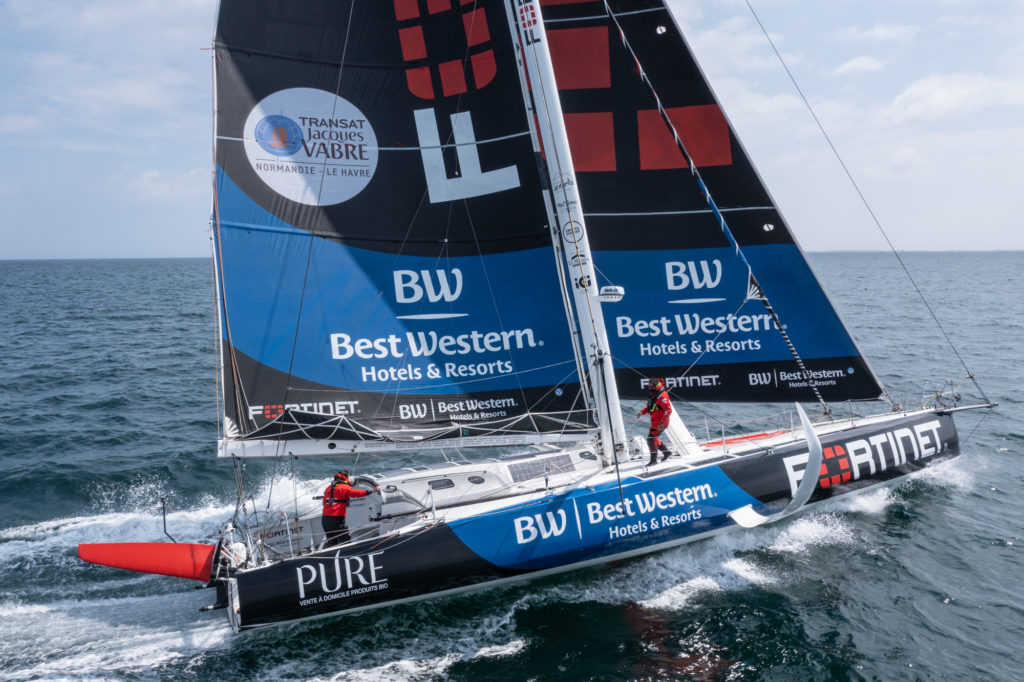TRANSAT JACQUES VABRE 2021: ATTANASIO, THE INTERVIEW PRIOR TO DOCKING OUT
| The countdown is on. On Sunday, Romain Attanasio and Sébastien Marsset will compete in their first transatlantic race aboard ‘Fortinet-Best Western’. The dockside buzz, management of the start, weather analysis and ambitions are becoming increasingly refined… Romain gives us the low-down on the key points of the race before setting sail. |
Time at this stage is coloured by an urge to set sail, to head out to sea, to think solely about the boat and a preference for actions over words. Romain Attanasio is already impatient to do battle with just a matter of hours until the start of this most prestigious of races to round off the season. Having spared no effort over recent months in tweaking their automatic reflexes aboard Fortinet-Best Western, Romain Attanasio and Sébastien Marsset eagerly await the opportunity to show what they’re made of offshore. Conditions at the start seem conducive for take-off and the focus will be on positioning themselves nicely from the get-go before powering down the Atlantic. How do you feel a few hours before setting off on this Transat Jacques Vabre? Pretty good! We know we’ve done all we can. The boat has never been so ready for action, and we’ve done as much sailing as we can over recent months. At every race start, it’s the same scenario: we are very happy to hook back up with partners and the public, and to have a series of exchanges for a few days. However, at some point, you get the sense that it’s time to get going. We’re just eager to set sail! It’s your 4th Transat Jacques Vabre and you’ve participated in two Vendée Globes and one Route du Rhum. What rituals do you have before start day? I don’t really have any. The day before the start, the schedule’s always very hectic. We’ll have two weather briefings, meetings with partners and a final briefing with the shore crew. The time just flies by. I hate the evening before battle, the final night before getting up at dawn to cross the Atlantic. My dread is that I sleep badly the night before the start. This is especially true if I know that the conditions are bad. Here though, the weather should be pretty good. |

“Life aboard is harsher”
So, what lies ahead for you in terms of conditions?
The start should be very photogenic with 15 to 20 knots of breeze on the beam, which will enable us to get the boats airborne. We’re going to be powering along at the start, but there will be less breeze at the north-west tip of Brittany. As a result, conditions won’t be difficult, there won’t be a big storm to kick off the race. We’re gearing up more for a downwind race. The key things will be to quickly get into the right group. Moreover, the trade wind won’t be very strong: there are unlikely to be any rough conditions until the doldrums.
Nevertheless, the start still needs to be approached with extreme vigilance…
Yes totally, it’s a tricky time, all the more so when you don’t yet have your sea legs (familiar with being at sea, able to keep your balance and not feel seasick) since you’ve spent the previous ten days on shore. We need to be on top of the navigation as there will be a lot of boats at the start. Next, in the English Channel, the shipping is always very intense, which means that you have to be particularly focused.
‘Fortinet-Best Western’ is one of the most high-performance ‘foilers’ (flying boats) in the fleet. How does that affect the way you apprehend danger?
Danger is omnipresent; it’s part and parcel of our sport. The difficulty lies in the way you apprehend it psychologically, especially so when a lot of elements cannot be predicted, like a mechanical issue or a collision with a UFO. Aboard a foiler, life is tougher, we’re more shaken about and wetter so there are considerable risks. By being quicker, the potential impacts are also more violent. However, over the years I’ve taken the time to adapt and learn and the experience that I’ve gradually acquired is invaluable in coping with all that.





